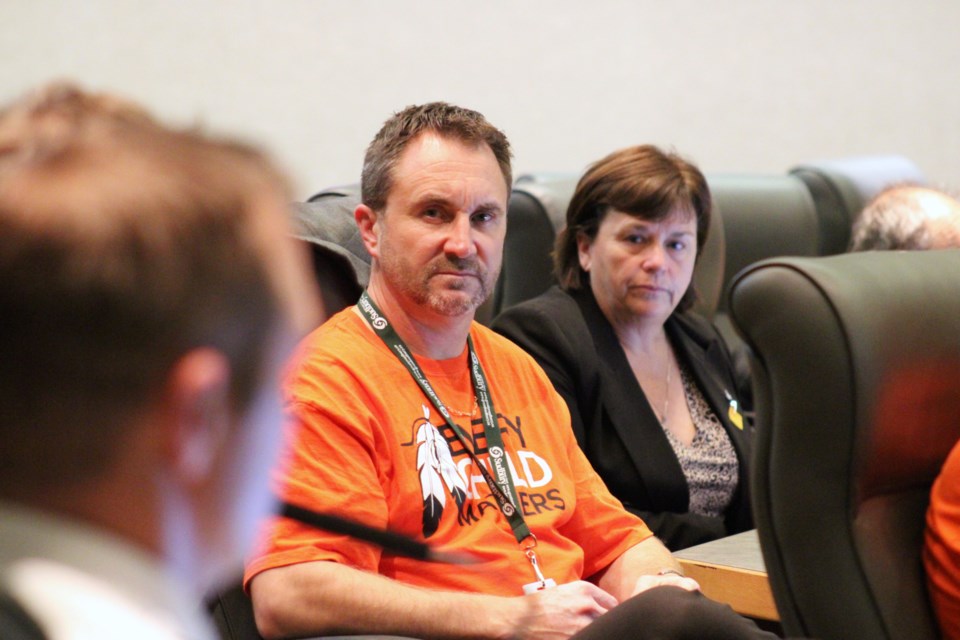Greater Sudbury’s elected officials have directed municipal staff to develop a strategy to end homelessness by 2030.
“With the housing crisis, people are being pushed out of places to live,” Ward 5 Coun. Mike Parent told his colleagues around council chambers on Sept. 26, while introducing the motion.
“We have renovictions so that landlords can profit more off the spaces they want to rent, and this in combination with other complex issues leads to more homelessness.
“My sincere fear is we’re going to see more of it over the next year or two.”
Parent’s successful motion, presented alongside Ward 4 Coun. Pauline Fortin, Ward 6 Coun. René Lapierre and Mayor Paul Lefebvre, cites a Housing First strategy as an effective solution. Housing First is the foundational policy of the federal and provincial government strategies, and has been used by the City since 2021.
The strategy, the motion explains, will ”include financial and staffing requirements to transition services from temporary shelters to transitional and permanent supported housing
City staff were directed to table the strategy by the end of March 2024.”
Although the city’s elected officials granted the motion unanimous support, it wasn’t without criticism.
“We’ve got a lot of people coming through our community,” Ward 9 Coun. Deb McIntosh said, cautioning that there will always be a flow of people experiencing homelessness.
“We can’t stop people from moving, our charter of rights allows us to move from place to place,” she said. “The municipality cannot end homelessness in isolation,” she added, noting they’ll need co-operation with various other agencies.
City Children and Social Services Director Tyler Campbell clarified to city council that the city averages approximately 33 people coming in from out of town per month as part of a flow of homeless people in and out of the community who need support.
While the last point-in-time count, done in 2021, showed that 72 per cent of homeless people in Sudbury are from outside the city, that number has changed significantly since.
City manager of housing stability and homelessness Gail Spencer told Sudbury.com in May, “We're not seeing a lot of new people from out of town, the majority of people are people from our community. They are either being newly evicted or have been released from hospital or corrections.”
Although McIntosh questioned the relevance of a 2030 deadline, Ward 1 Coun. Mark Signoretti argued, “We need a timeline; we need an aggressive timeline.”
While it might seem ambitious, Parent said, “The greater danger is not setting the bar high and not quite reaching it, the greater danger is setting the bar low.”
In a presentation to city council, Campell cited various efforts to combat homelessness the city has already been undertaking, including the ongoing construction of a 40-unit transitional housing complex on Lorraine Street and the deployment of an Assertive Community Treatment Team of clinicians to help people experiencing homelessness find success in permanent community housing.
In an emotional plea, Fortin said that despite all these and other efforts, “things are not improving. We have normalized the unfortunate circumstances of our most vulnerable population, and the trouble with normalizing things is they only get worse.”
The city needs to take more “bold and decisive” steps, she added.
The latest homelessness statistics, shared by Campbell, count 708 people as having been added to the city’s by-name list since 2021.
The by-name list is a count of people experiencing homelessness which includes detailed information about each person’s needs.
Of the 708 people on the list, approximately 183 have been moved to inactive, meaning they’ve relocated to another community, become incarcerated or died.
This leaves a net 525 people, of whom 308 have been housed, leaving 217 on the current list.
Approximately 10 per cent of people on the by-name list who have been housed have ended up returning to homelessness, Campbell said.
Although approximately 41 people currently living in encampments are part of the 217-member by-name list, city housing stability and homelessness manager Gail Spencer estimates that an additional 80 people live in encampments.
“It takes quite a bit of time to create that rapport with people before they’ll agree to have their name on (to the by-name list),” she explained.
Within the strategy city staff ends up drafting for city council consideration by the end of March 2024, city community development general manager Steve Jacques said the established housing supply issue, both in the private and public sectors, will be highlighted.
“That is going to be our No. 1 challenge, is building enough housing so that ... anybody who wants housing or needs housing within our community, we have an opportunity to provide that to them with wraparound services to ensure they have and maintain a successful tenancy,” Jacques said.
“Without housing, individuals without housing, all the rest doesn’t really matter. They need safe and secure housing for themselves for them to be able to address any other barriers they might face.”
-with files from Jenny Lamothe
Tyler Clarke covers city hall and political affairs for Sudbury.com. With files from Jenny Lamothe.




